I had heard of him tangentially but had never followed the leads until I saw several of his films on Shudder. French, stylized, a bit low-budget yet attractive. A good reference for Rollin’s films is DISCOVER–where to start with the films of Jean Rollin from IMDB. I went with three in the vampire series, minus his first feature “The Rape of the Vampire”:
The Shivers of the Vampires (1971)
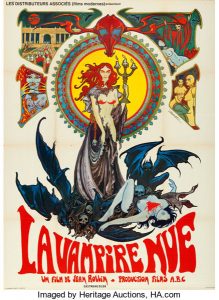
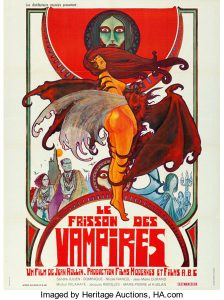
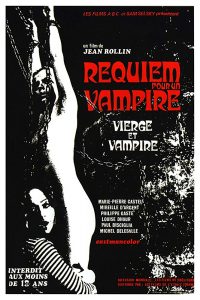
The Nude Vampire (1970)
Watched on Shudder.
Boy tries to rescue girl from attackers in the city at night. She is killed (apparently) but he follows the killers to their mansion and discover that they are a group, led by his father, using the girl to replicate her immortality. She is not dead! This is about vampires that are not, in fact, vampires but rather mutants representing the future of the human race from another dimension. There is nothing not to love about that.
Stylish in a French way that is different than Argento’s Italian way but just as heavily stylized. And the outfits my god the outfits. I hate to pigeonhole a nationality, but I can see where the haute couture of The Fifth Element came from. A single odd characteristic to express the style is the Castel sisters’ submissive outfits (think a less enlightened version of Rodriguez’s babysitter twins):
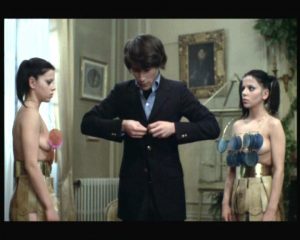
Some weird free jazz soundtrack by Yvon Gerault, plus mannerist performances, plus 70s commedia dell’arte outfits made for a great introduction to Rollin.
- IMDB
- The Nude Vampire (1970) – review from Midnight Only
- The Nude Vampire – review – from Taliesen meets the vampires
- Rotten Tomatoes
- Wikipedia
The Shivers of the Vampires (1971)
Watched on Tubi (free with ads).
Newlyweds Isle and Antoine travel for their honeymoon to a castle that the bride’s cousins own. There, she becomes seduced by a female vampire and by her cousins who were vampire hunters who were tragically turned in an exposition scene. Isle becomes more and more distant as Antoine discovers the strange rituals that are held at night. The couple and the two cousins are mirrored by another duo, that of two non-vampire maids as Renfield characters enslaved to the vampires (one of the maids is a Castel sister from the previous movie). Static, beautiful scenes and more haute fashion, elliptical dialog, and an intriguing ending.
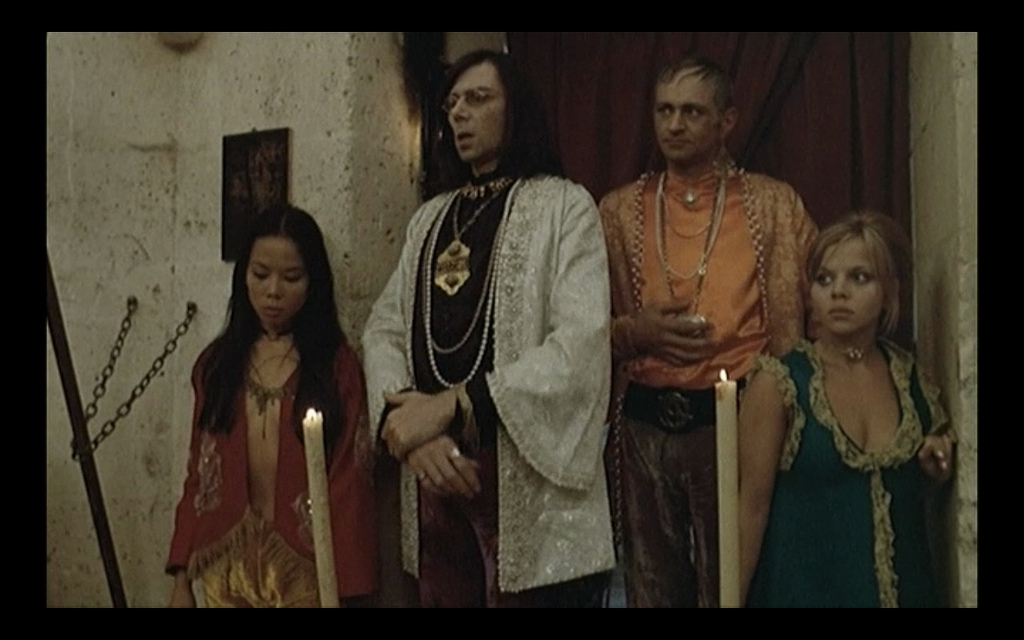
Some notes taken throughout the film:
Zoom and blurred closeups on faces like in Jess Franco’s work. Some really very good framing and exotic lighting and color palette, contrasting hues, but the camera movement is poor. Argento lighting.
The artifice feels like it could be an opera.
Similar story components as The Nude Vampire? A couple where the female has supernatural value. Relatives with a mystery, here they are hers instead of his. The building where the mystery is manifest is a central part of the story, almost a character in itself.
Great scenes with the lead female vampire: she first appears when Isle opens a grandfather clock and she is inside (!). Later in the film she floats down into a large fireplace from inside the chimney (!!). I now recognize their birth-like moments, but representing the birth of Isle as a vampire.
Lack of sexual attraction with the couple. The bride takes hair down only after the groom leaves the bedroom. She keeps putting off consummating the marriage. Did she say to him at one point “You wanted the only behavior that was appropriate: silence”? I had written that down.
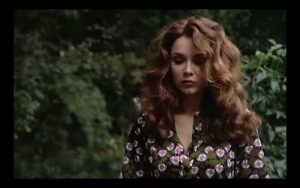
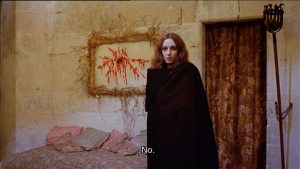
The vampire-hunting cousins are like men who have returned from the crusades wounded and who have lost their faith, here their wounds are on their necks and their lack of faith has turned them to vampires. They kill a woman that they had previously turned (“she was the last connection with our former life.”). A philosophical statement to the unturned couple: “you have your own tombs to escape the light of day”. Many moments of heavy-ish-handed symbolism. The cousins almost always speak directly to the camera and swap sentences quickly back and forth, as if they are one character. At the end of speeches they in finish in chorus. Their outfits are 60s style, but still somewhat excessive and effeminate.
Soundtrack different than the previous. This has spare, twangy, poorly played, out of tune guitars, at times psychedelic at others punk. The band is Acanthus or Groupe Acanthus, Daniel Buffet and Gerard Sallette. Once called Unity (22) with additional members Francis Bendichou, Guy Ouly, and Leo Leonard. Very little output and for good reason. Their sound works for the movie though.
- IMDB
- Jean Rollin – Le Frisson Des Vampires – review and lengthy analysis by Iain McLachlan, highly recommended, he elaborates more fully on the points that I had noted
- Rotten Tomatoes
- The Shiver of the Vampire – review at Kanopy
- Shiver of the Vampires (1971) – review at Midnight Only
- Wikipedia
Requiem for a Vampire (1971)
Watched on Hoopla (free from the Atlanta Fulton Public Library System).
We enter in medias res with two girls, dressed as clowns, and a wounded guy in a car chase across the countryside. It’s uncertain why they are being chased. The duo survives–Marie-Pierre Castel as Marie, this time in a larger roll, and Mireille Dargent as Michelle–and escapes on foot and through fields and on a motorcycle until they end up at a castle. There, vampires and vampire-minions capture and attempt to turn them. The leader, the last vampire, is both menacing and sympathetic and can no longer turn others because of his age. The film swings from madcap to moody to pornographic and finally to elegiac.
Notes:
Once arrived at the graveyard and before they get to the castle, Michelle falls into a grave and is knocked unconscious. Two gravediggers arrive and, not seeing her, bury her atop the casket. Marie pulls her out; death to life. Michelle later is the one to succumb to the vampires.
The camera often lingers on the faces of the duo as they experience uncertainty or danger. And at one point they address one of the vampires together, swapping sentences like the cousins in the previous film. They are one character.
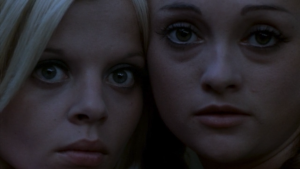
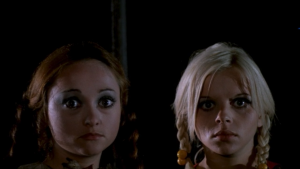
Once one starts to become a vampire, they are viewed only separately.
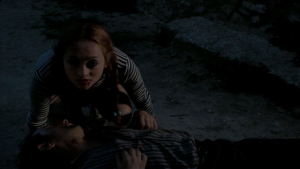
A castle is a primary, magical character just as in the last film. The castle’s courtyard gate acts as a portal between the worlds. When they first enter, the camera lingers on the gate as it slowly closes. Marie brings a lover to the gate but begs him not to enter and doom himself. When they try to escape, they run into the woods only to exit back where they started. Space is warped.
Random creepy/surreal touches: as in the previous movie skulls decorate walls and doors, hands jut from windows, doors, and random openings in the walls, unmoving and sometime holding candles.
The actress Dominique, from the previous film, plays a similar roll as haute/psychedelic Svengali.
Much of the story arc maps to modern horror where refugees end up in the clutches of deranged families or killers (a la The Texas Chainsaw Massacre). The clan of vampires and vampire minions are collecting lost women as food/sex slaves. There’s an extended rape/orgy scene that moved into the pornographic (but with some of the best music in the soundtrack) and was out of character from the previous two films. But really just this side of pornography.
The duo’s time in the castle contains frequent humorous escapades as they flee from one danger to another. Most/all of it without dialog and so evoking silent film slapstick.
One of the female minions tells them during an indoctrination scene: “you cannot be both virgin and vampire”. The duo take different paths, but end up together as at the beginning of the film. Lovers and friends.